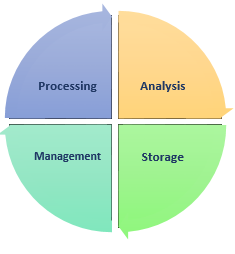Top 5 factors to consider while testing Financial Applications
A report by Research and Markets estimates that the global Financial Services Application Market will clock $103.66 billion by 2019, at a CAGR of 9.1% during the forecast period 2014-2019. Today the strength of a country is estimated by the robustness of its economy and allied financial systems. Ensuring security and accessibility of the financial applications is critical, which has hiked the significance of Financial Applications Testing and Quality Assurance – Security testing, Functional testing, Load/Performance testing, and more.
Financial technology organizations (commonly referred to as Fintechs) emerged to become a craze in 2015, and start-ups raised volumes of funds from banks and financial institutions to develop innovative platforms to make financial services more accessible and use-friendly. The key concern areas have been performance, security, and functionality.
Interestingly, KPMG report states that ‘Last year, financing for fintech start-ups hit over $20 billion, a 66 percent increase on the $12 billion recorded in 2014.’ Isn’t this space getting exciting?
It sure is. But is it also bug-free and secure?
Testing financial applications are getting complex, as applications are getting further multi-layered due to growing third-party connections. A financial application facilitates management of business processes for financial transactions. It is designed to automate, enable, and store sensitive financial data securely.
Financial Services applications manage the overall storage of sensitive data, analysis, management and processing of a bunch of financial transactions, data sets and information to deliver a robust platform for the end users.
Financial software is designed on the basis of financial information management, which can run as an independent software or as a component of financial information system as well. It is built for both personal and business purposes and comprises features such as basic financial data management, financial transactions and management, budgeting, and financial assets management.
A Financial Application is built with multi-tier functionality to serve multiple concurrent users/user sessions even on a large scale. A banking/financial application integrates with various other regulatory or supplementary applications, namely, payment gateway services, merchants, and trading accounts.
Financial application processing entails multiple integration points and generates complex business workflows. It further involves Real Time and Batch Processing with volumes of transactions per second. This typically makes software testing for financial applications complex.
Can you imagine loading your sensitive data on an application if its security is questionable and its performance is not as expected?
Security and Performance are critical when it comes to financial services applications. Fintech startups are getting big bucks and funding, but at the same time they are struggling to keep the platform secure and upgraded for enhanced customer experience.
5 Critical aspects to consider while testing Financial/Banking applications:
- Impact Analysis
It involves analyzing the effect of the changes on the deployed application. It focuses on the features of the application that could be possibly and indirectly impacted by the changes in the application and might require scrupulous regression testing. This decision and analysis is generally done as a team.
The team involved in the financial application’s Quality Assurance is expected to identify areas that could be affected and eventually get them fixed. The technique is referred to as selective re-testing, as it focuses on reusing the existing test cases that have been already executed.
- Functional Testing
Functional Testing is an essential aspect in software testing of financial applications. It is important to test the system with complete knowledge and check all source codes and architecture for bugs or any kind of vulnerabilities effectively.
Functional testing of financial applications comprises the regular software testing activities: Test Case Preparation, Test Case Review, and Test Case execution. It can further involve Application testing, System Integration testing, Regression testing, and User Acceptance Testing as well.
- Security Testing
Security Testing is normally considered towards the end of the testing cycle after completing functional and non-functional aspects of the application. However, the dynamics and processes need to change with time. Financial applications are enabling the trade of millions of dollars in the form of stocks, goods, currency, and more.
This means, you need to watch out financial breaches and take care of the sensitive areas on a proactive basis. Security testing helps you check for vulnerabilities and address them in compliance with Federal and industry standards. It helps check vulnerabilities across every platform – Web browsers and Mobile Applications.
- Performance Testing
Financial services applications are venturing into diverse market and products, which requires more judgement of the expected load on the application. This drives the need for performance testing across the development lifecycle. It helps estimate, test, and manage load on the system and accordingly build the application.
The applications are expected to adapt to the changing economic ecosystem and fast-paced applications development cycles. There are some key benefits of Performance testing, namely, monitoring and reporting, enhanced productivity, reduced costs, and reduced down-time. All in all, this helps in ensuring enhanced quality and better experience for the customers.
- Test Automation
Most of the financial services applications require rigorous testing, as they experience many different scenarios. Test Automation makes the process iterative and eliminates any errors that can occur due to manual efforts. This can be done with automated test scripts/frameworks.
This will further ensure that all kinds of user interactions are tested and the team is able to achieve enhanced test coverage. Test Automation can be implemented across different software testing activities – performance/stress testing, security testing, and functional testing.
The objective is to make the process faster, sustain quality, and achieve maximum test coverage.
Efficiency and robustness of the financial applications can be improved with proactive testing approach and effective risk management. It is definitely a challenging space, thanks to the wider scope and reach of the applications in the economic sphere.
Cigniti’s Advisory and Transformation Services help enterprises and innovative business ventures to focus on Quality Assurance and Testing aspects – people, tools, and infrastructure across the delivery lifecycle.
Connect with us to transform your QA practices and devise the right strategy to test your complex and business-critical applications.






Leave a Reply